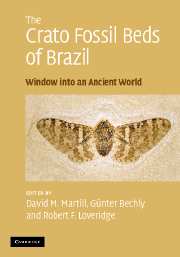Book contents
Preface
Published online by Cambridge University Press: 22 August 2009
Summary
In the late 1830s Scottish botanist, surgeon and explorer George Gardner (1810–1849) made his way on horseback from the picturesque spring-line village of Brejo Grande towards the now palaeontologically famous town of Santana do Cariri on the flanks of the Chapada do Araripe. In his published diaries (Gardner, 1846) it is noted that parts of the track were naturally paved in a slabby limestone. Some of these exposures still exist, although this picturesque country track has recently been resurfaced. What Gardner didn't record was that these limestones contain a wealth of fossils, some of which are spectacularly preserved and the raison d'être for this book. Although primarily a botanist, Gardner had a keen interest in fossils and, just a few weeks earlier, he had been exploring outcrops where carbonate nodules contained three-dimensionally preserved fishes: the so-called Santana Formation fish nodules, often seen for sale in fossil shops around the world.
Gardner shipped many of the fish-bearing nodules back to Scotland where they formed the basis of studies by the famous ichthyologist Louis Agassiz (1807–1873; Agassiz, 1841, 1833–1844a, 1844b), but the fossils in the slabby limestones seemed to pass him by. Perhaps it was because few quarries excavated the stone at this time, houses then being constructed mainly of mud and sticks or, for the wealthier, bricks made in the traditional style using locally dug alluvial clays.
Even 20 years ago fossils from the Crato Formation were still hardly known.
- Type
- Chapter
- Information
- The Crato Fossil Beds of BrazilWindow into an Ancient World, pp. xi - xiiiPublisher: Cambridge University PressPrint publication year: 2007



